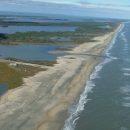What We Do
The New Jersey Field Office works with experts, conservation groups, landowners, and many others to protect and recover threatened and endangered species. We coordinate with federal and state agencies, local governments, the business community, and private citizens to make sure that wildlife resources are considered during project planning, such as for transportation, energy, coastal management, and development. New Jersey Field Office biologists serve on oil spill response teams, investigate the effects of environmental contamination, and work to restore polluted habitats. And we work with private landowners to restore fish and wildlife habitats.
Here are some of our focal programs in New Jersey:
Conservation Planning Assistance
Endangered Species
Environmental Response and Restoration
Partners for Fish and Wildlife
Management and Conservation
Field office biologists work with landowners, private and community organizations, industry, and other government agencies to conserve, protect and enhance fish and wildlife resources and their habitats in New Jersey. Some of our conservation activities include:
- Review proposals for projects that may affect natural resources, including endangered species, migratory birds, and interjurisdictional fish.
- Work with others to recover endangered species.
- Work with others to restore wetlands.
- Work with landowners to restore habitat for fish and wildlife.
- Assess contaminant effects on fish and wildlife resources and seek compensation for damages.
- Respond to oil spills.
The New Jersey Field office has established four geographic focal areas: the New Jersey Highlands, the Hudson/Raritan Estuary, the Atlantic Coast, and the Delaware Bay. We assess our strategic conservation priorities each year, and have established the following current focal areas.
- At-risk species
- Aquatic connectivity
- Coastal resilience coordination
- Swamp pink recovery
- Natural Resources Damage Assessments
Other work priorities for our office include beach landscape species recovery, bog turtle habitat restoration, addressing re-contamination risks from wetland restoration, riparian riparian
Definition of riparian habitat or riparian areas.
Learn more about riparian habitat restoration, recovery of listed bat species, spill response, and coordination with other agencies.
Laws and Regulations
Field office biologists work with landowners, private and community organizations, industry, and other government agencies to conserve, protect and enhance fish and wildlife resources and their habitats in New Jersey. Our work is guided by various laws and legislative authorities.






